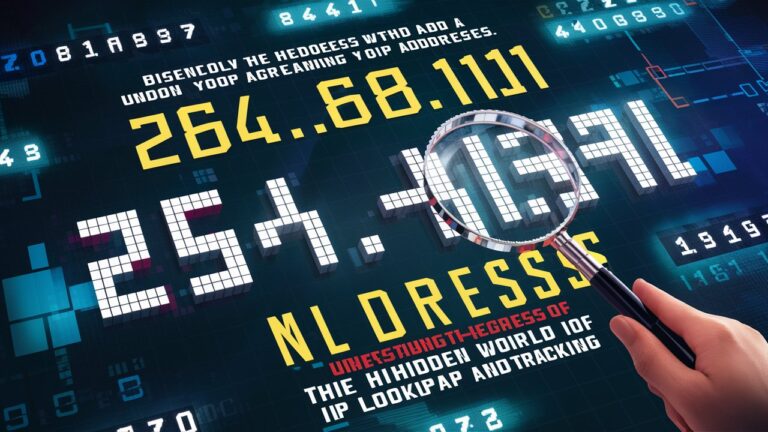Introduction
In the digital world, every device connected to the internet is identified by a unique IP address. One such example is 264.68.111.161, which has caught the attention of many users online who are curious to know what it represents. While it looks like a regular IP address, not all numeric combinations are necessarily valid or active on the internet. Understanding whether an address like 264.68.111.161 is real, how IP addresses work, and how they can be tracked is crucial in learning about the backbone of internet communication. This article will explain the basics of this IP, its validity, how IP addresses function, and how to look up such addresses to find details like ISP, location, and server data.
Understanding the Structure of IP Addresses
An IP address is a unique numerical label assigned to each device connected to the internet. The most common format, IPv4, uses four sets of numbers ranging from 0 to 255 separated by dots (e.g., 192.168.1.1). This means that an address like 264.68.111.161 does not actually fall within the valid range, since the first block “264” exceeds the maximum limit of 255. This makes 264.68.111.161 an invalid IPv4 address. However, addresses like this are sometimes used in technical discussions, testing examples, or even placeholder data to explain how IPs function.
Is 264.68.111.161 a Valid IP Address?
The short answer is no. Because IPv4 addresses are limited to numbers between 0–255 in each of the four octets, the address 264.68.111.161 cannot exist on the internet. If you attempt to perform an IP lookup or trace it, no real network location, ISP, or server data will appear. This is different from valid addresses that can be geolocated to countries, internet providers, and even cities. The inclusion of “264” makes it immediately clear that it is not part of the IPv4 space. However, this discussion opens up the opportunity to explore why some numbers are invalid, and how IP addressing has evolved into IPv6 to support the growing internet demand.
The Importance of IPv4 and the Transition to IPv6
IPv4 was designed in the 1980s and provided around 4.3 billion possible addresses. At the time, this seemed like an enormous number, but with the rapid growth of smartphones, computers, IoT devices, and servers, these addresses began to run out. This led to the introduction of IPv6, which uses a much larger set of alphanumeric combinations (like 2001:0db8:85a3:0000:0000:8a2e:0370:7334). Unlike IPv4, IPv6 can support trillions of devices, ensuring the internet continues to expand. When users come across invalid IPv4 addresses like 264.68.111.161, it highlights the strict rules IPv4 must follow and why a newer system was required.
How to Perform an IP Lookup for Any Address
Even though 264.68.111.161 is invalid, it’s useful to know how you can perform an IP lookup for valid addresses. An IP lookup reveals details such as:
-
Geographic Location: The approximate country and city of the device.
-
ISP Information: The internet service provider managing the address.
-
Server Data: If it’s tied to a hosting company or data center.
-
Blacklist Status: Whether the IP has been flagged for spam or suspicious activity.
Free online tools and WHOIS databases make it easy to enter an IP and retrieve this information. However, remember that IP addresses generally give approximate data, not exact home addresses, in order to protect user privacy.
Why Invalid IPs Like 264.68.111.161 Still Appear Online
Sometimes, invalid IPs are included in examples in textbooks, online tutorials, or discussions about networking. They may also appear in incorrectly configured systems or logs. In rare cases, users search for them because of errors in typing or confusion with similar valid addresses. Instead of being active network addresses, they serve as teaching moments for explaining how IPs work.
Conclusion
The address 264.68.111.161 is not a valid IPv4 address because it exceeds the number range of 0–255 in its first octet. However, exploring this example helps us understand the structure of IP addresses, the limitations of IPv4, and the importance of IPv6 in today’s internet landscape. While you cannot perform a valid lookup on 264.68.111.161, the process of investigating it highlights how essential IP addressing is to global connectivity. Ultimately, even invalid IPs serve as reminders of the rules governing our digital world and the systems designed to keep it functioning smoothly.
❓ Frequently Asked Questions (FAQ)
Q1: Is 264.68.111.161 a real IP address?
No, it is not valid because the number 264 is outside the allowed range of 0–255 in IPv4 addresses.
Q2: What happens if I try to trace 264.68.111.161?
An IP lookup will not return real information, since the address cannot exist on the internet.
Q3: Why do some websites show IPs like 264.68.111.161?
These are often used as placeholders, examples, or appear due to typing errors.
Q4: How do I check the location of a valid IP address?
You can use free IP lookup tools, WHOIS services, or geolocation databases to find approximate location and ISP details.
Q5: What’s the difference between IPv4 and IPv6?
IPv4 uses a numeric system with four sets of numbers (0–255), while IPv6 uses longer alphanumeric combinations to support trillions of unique devices.
